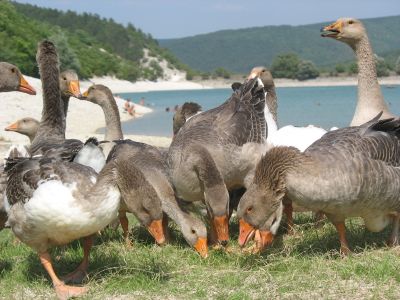
You take great pride in your lawn. You feed it, weed it, mow it and admire it. But most importantly, you want to protect it.
One threat to your lawn is the activity of pest birds. In particular, large birds like geese and ducks who often graze on green lawns, leaving ugly bare patches. Or annoying, busy-body birds like crows who can quickly ruin a beautiful lawn by digging for grubs. The divots they leave can leave a lawn looking shoddy and damaged. There’s also the accumulation of bird droppings, which is not only unsightly but infested with diseases like E. coli and Salmonella. You don’t want that on your lawn, especially if you have children playing on it.Compounding the problem is the fact that nesting geese and ducks can also be quite territorial. If they feel threatened while grazing on your lawn they will go after small children and pets. As a homeowner, you know better than to go after these protected birds with poisons or pellet guns—especially if you have children, pets and sensitive neighbors. You also know from past experience that simply blasting pest birds with a garden hose is fairly ineffective—unless you stand guard with a hose 24/7. You’ve come to realize that the only way to keep pest birds away from your lawn is to implement the effective and humane deterrents used by professional bird control experts. Here are three bird deterrents that will do the trick:ScarecrowEasily attached to any garden hose, Scarecrow's hit invading birds with a harmless blast of water. Perfect for lawns, the Scarecrow uses just 2 to 3 cups of water per spray, yet covers a full 1,200 square feet with a stream that reaches out 35 feet and 45 feet wide. The scarecrow stands guard, day and night for up to 6 months (over 1,000 "firings") on a single 9-volt battery. Hawk DecoyMost birds avoid any areas where hawks are present. Place one or two of these hawk decoys in a highly visible position and say good-bye to pest birds converging on your lawn. It’s important to get quality made realistic looking decoys, and to move them around often to convince birds the decoys are a “live” threat. Some decoys are hollow at the base so you can fill them with sand for added stability. Sonic Goose DeterrentsIdeal for large lawns, Sonic Goose Deterrents broadcast goose distress and predator calls that resemble normal bird sounds to humans (so they won’t irritate pets or your friends and neighbors). If you’ve got all manner of birds attacking your lawn, get the Goose-B-Gone Supersonic system. It can emit distress and predator calls of geese. This unit covers up to an acre and can be programmed to turn on or off at night.
